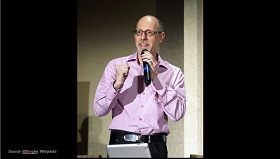According to Warren Buffet, the one skill that raises your value by 50% is public speaking.
This comes from the same man who signed up for public speaking class and then dropped out before attending a single class.
And I can empathize. The scariest thing I did in 2016? Public speaking.
Before we begin…
Before we get into the tips, I wanted to elaborate on why I got into public speaking. I want to explain how I improved so you can understand where the tips come from and why you should apply them to yourself.
Keep your goals secret
One of my goals last year was to become a better public speaker. My life goal is to be an accomplished raconteur, and I figured that a way to force myself to become better at storytelling was to do public speaking.
At its essence, public speaking is about yarning an engaging story that contains a lesson or two along the way.
And the best way to get good at something is to do it, analyze what you did right (and wrong), and rinse and repeat.
Although I set a few goals for myself ever year, I never post them publicly – studies have shown that talking about your intentions (and then subsequently receiving positive feedback) results in your mind being “tricked” into thinking it has already accomplished your goal. You’re now satisfied with all that praise and love and are less likely to hit your target.
Some goals are best kept to yourself or with a small group of trusted people
Precise practice makes perfect
In 2016, I spoke 26 different times.
The audience ranged from the small – a fireside chat with five people in attendance – to the large – 600+ people.
The events ranged from the incredibly-well-run (eg Big Omaha) to the “how do they not have a computer to put the presentation on?”
The experience ranged from the downright nerve-wracking to the “I’m a boss and cannot wait to kick ass and take names.”
If you want to improve as a public speaker, then embrace every opportunity to participate and progress.
Getting better is not fun
The process was brutal. I used to think hearing just my recorded voice was uncomfortable – nope! Add a visual component, and it becomes 10x worse as you notice every odd tic and fidget.
So I solicited feedback wherever I could. I recorded each talk and broke it down. I analyzed my tendencies to smooth out all of the rough edges.
Record your videos so you can look over them to figure out how you can improve.
Don’t trust yourself; trust experts
I’m also a big believer in talking to experts to shortcut some of the pains of learning, and I was lucky enough to have access to brilliant dudes like Joey Coleman and Ron Tsang (to name a few) who helped sharpen my capabilities (side note: I highly recommend hiring them). Without them, I’d be 40% as good as I am now.
Hire a coach. They can pinpoint mistakes you make and help you become 10x better 10x faster.
Five key components of public speaking
Now, I wouldn’t go so far as to say I’m a great speaker now, but with my ego in check, I would rate myself as above average.
As I progressed, I took a ton of notes, and I’m going to share how you can apply them to yourself.
I find that most people who write about public speaking either just vomit out a few items on what they’ve learned, OR they focus on just one aspect of the talk.
What I’ve opted to do is break it down in the five areas I think are most important, talk about the goal, and then give you some actionable items for each.
The areas I am going to cover are:
- Content
- Slides
- Before
- During
- After
Content for your talk? That should be the easy part!
I treat content and the slides separately. You come up with the structure of what you’ll be talking about (content), and then the slides are what give you the POW.
I continually preach “I am not here to impress my peers” (more on that later) – if you’re talking, you better be an expert.
When I say expert, I don’t necessarily mean world’s foremost expert. Relative to the people attending, you should be an expert.
And as the expert, the content should be no problemo.
When starting from scratch, I follow the ensuing process to create an outline:
1. “Because of my presentation, you will understand ____________”
I start by filling in the blank: “Because of my presentation, you will understand ____________.”
Let’s build a real example: “Because of my presentation, you will understand why email marketing is superior to social media.”
This simple line is the overarching point of your talk and sums up the information you are trying to convey.
2. The major points that lead to the above understanding
You will then have major points that lead to the above understanding. Each of these major points will either solve a pain or give you pleasure.
Think of these as the major bullet points of your talk; the sections that put your message together.
Going back to our example on “Why email marketing is superior to social media,” we end up with the following major points:
- Business is about making money, and thus we need to focus on ROI
- So why do people care so much about social media?
- Compare and contrast, so you understand how the two are different and how that impacts you
- Traffic from email list versus going viral
- The actual ROI numbers for email marketing (statistics)
- How email marketing works
- Real life examples of email marketing
There’s a natural progression – I remind everyone what our goal is, I talk about why people do love social media, I breakdown the contrast, I talk about traffic generation, I nail you with the #s that convince you that email > social media, and then I fully break down how it works and how others do it.
Natural progression in your major points
3. Each major point has a hook
Each major point has a resulting hook. Each of these hooks breaks down something intrinsic to what people care about.
Going back to our example:
- Business is about making money, and thus we need to focus on ROI → What IS the purpose of business?
- So why do people care so much about social media? → Why social media?
- Compare and contrast, so you understand how the two are different and how that impacts you → Comparing social media vs email
- Traffic from email list versus going viral → Email will generate you the most traffic
- The actual ROI numbers for email marketing (statistics) → The statistical superiority of email
- How email marketing works → How to make email marketing work for you
- Real life examples of email marketing → How the pros collect email addresses
The “hook” is just rephrasing your major points so it piques people’s curiosity, usually to answer a what, how, or why.
4. Break down each hook into sub points
Each major point will take 5-10 minutes to cover. It should thus have sub-points that will take roughly 1-2 minutes to break down.
Back to our example:
- What IS the purpose of business?
- Sales is built on trust
- Trust is built on buy-in
- Buy-in is easiest when you have a relationship
- Why social media?
- It’s trendy
- It gives us #s
- It’s instantaneous
- It makes us feel good
- It makes us feel connected and in-the-know
- None of that matters (great example – Beyoncé has almost 15 million followers on twitter, and has only tweeted once since August 2013)
- Opportunity cost
- Comparing social media vs email
- Easy to optin vs more commitment
- Middleman vs direct
- Distractions vs singular goal
- Seen as fun/personal usage vs business/commercial
- No control of message flow vs full control based on interactions
- General targeting vs very specific targeting
- Email will generate you the most traffic
- Examine.com Insiders vs going “viral”
- Value of each subscriber – email vs Facebook vs Twitter
- Derek Halpern Twitter vs email subscriber test
- Ogilvy findings
- The statistical superiority of email
- Highest ROI (Econsultancy)
- Custora LTV
- DMA ROI
- monetate results
- How to make email marketing work for you
- Back to buy-in
- If I was going to sell you nutrition training, how would I do that? (Story of me being fat to fit to connect)
- It is like dating
- Once you’ve built that trust, you can sell
- Back to dating – getting the phone # is the equivalent of getting an email
- Offer something worthwhile
- How the pros collect email addresses
- Real life examples
5. Your expertise is now ready to be made into a talk.
That’s it!
I may sound glib, but all you are doing is building a basic outline in talking about something you know. We’re operating under the assumption that you know your stuff – if you don’t, the outline is going to be tough. If you do, it will just come tumbling out.
As the expert, you don’t need to memorize; you should be able to ad-lib. Your outline just ensures you stay on point.
The content is just an outline of the overarching topic, the major points under it, and the hooks under each major point.
Slides: bringing the POW
The actual presentation is where most people screw up. If you remember one thing, let it be this:
Your slides are a visual aid to what you are saying. They are not meant to be the focus.
The goal of the slides is to help give pop what you’re saying. We think in a rapid-fire manner; as such, your slides should also unveil themselves in a similar manner.
Each slide has a very specific point, nothing more, nothing less.
You don’t want to dilly-dally on your slides – you make your point, the slides make that point pop, and you move on.
So if you spend more than 60s on a slide, you’re slowing everyone down.
Think of when you’re singing a song. You may not actively remember the lyrics, but as you’re singing, the next words come out naturally.
Your slides are the same. Once you get started, you’ll know what the next slide is (and that will help keep your talk going).
A great presentation FLOWS. Partly why you adlib your talk is because it flows a lot more naturally, and the slides naturally help constrain you to the topic at hand.
A ~45-minute talk will have anywhere from ~100-150 slides. As I go through it, the slides keep me going and keep the audience far more engaged.
For example, in one of my talks, I mention Richard Wiseman, a magician turned psychologist who studied luck.
A typically tedious presentation would go like this:

“I want to talk about Richard Wiseman, a magician turned psychologist who researches the lucky vs the unlucky.”
A more interesting way of presenting it would be:

“I want to talk about Richard Wiseman; a magician turned psychologist who researches the”

“lucky vs the”

“unlucky.”
Voila! See how the slides are making the impact of your words so much stronger?
13 key points for your slides:
- Slides are meant to be visual aids
- Give visual cues to focus your audience’s attention:
- Try not to have more than a dozen words per slide
- If you have multiple points animate them.
- Don’t show them all at once; have them come in one at a time
- Fade your older bullet points out
- Try not to have more than a dozen words per slide
- Speak in pictures
- The headline/text should be above the image, not below
- Always credit the original photographer or source
- Your slides are your outline – they take you from one point to another. I can do up to 175 in an hour – they are there to hit a point, not just sit there in the background
- Don’t spend more than 60s on a slide
- Personalize each talk to the event/location
- Customize your intro to the audience
- Slides are complementary, not the focus
- Slides should match your words (to reinforce)
- Close each ‘section’ with a loop back/conclusion
- Your job is to change their mindset. Then they can implement the actions
[convertkit]
Before the Talk
Your presentation is ready, and the conference is coming up, so it’s time to get ready.
Preparation is key.
I used to be so nervous about giving talks. But I discovered something – it was always the first few minutes that were brutal. Once you were in the flow, it wasn’t too bad.
Thus, a twofold solution:
- I would memorize the first five lines I was going to say. This would get me in the flow and then I’d ad-lib the entire talk.
- I’d take a half shot of liquor before I went on stage. It didn’t even matter what it was – as long as it was 80 proof, that was good enough for me.
NOTE: I’m a lightweight, so that’s why only half a shot. The more hardy drinkers reading this may find that too little.
I’m now far more confident in “I’m the expert here,” so no more alcohol for me. I still memorize the first few lines to get me flowing.
14 key points to be prepped with before your talk:
- PRACTICE telling stories to your friends and other people you meet
- The intro sets you up. It’s social proof via a third party. Customize your intro per event
- Be a professional. Bring presentation on a USB. Have it uploaded in the cloud. Bring a laptop. Bring a clicker.
- Know the situation at the event
- Background (don’t ever wear patterns or have your shirt be the same color).
- Setup – check the size of the room, where you will be, where your presentation will project, if there is a podium.
- Aids – will you have a clicker? Will you be mic’d up or will you hold a mic?
- Have the gall to ask for a speaking fee
- Do your research beforehand! Know who else is speaking, what’s around, etc.
- Join the conversation – hashtags, etc
- Be a professional – take your talk seriously
- Practice exactly as you will present (same clothes, position, even time)
- Watch out for armpit stains (wear an undershirt)
- Articles you write can become your talks (and vice versa)
- It is perfectly normal to be a bit nervous
- Expect and own the things that can go wrong. Just don’t dwell on them.
- Worst case, take a half shot of liquor.
Talk Time
OK humans – it’s show time.
I don’t agree with stupid cliches such as “see everyone as naked.”
What actually helped me with my jitters was this: “I am not here to impress my peers.”
The simple truth: I’m speaking because the people listening do not know as much as me.
That’s it. That’s why I’m here. On this one very particular area I’m talking about, I am the expert. And the people attending and listening are the non-experts.
At the end of the day, I think of it as me chatting with a friend on a topic he doesn’t know about, and I’m educating him with my knowledge.
25 key points for your talk:
- Find your anchor. This is the person who is deeply into what you’re saying; any time you think people are bored, just look their way.
- Be a lighthouse – scan your light over everyone
- A little contrarianism can go a long way. Challenge assumptions and orthodoxies.
- You are not here to impress your peers
- You are speaking because you know more than the people listening. Not true? Don’t speak.
- Nothing to be shy about, you know your stuff
- Use stories
- Be slightly more dressed up
- Pause not for effect, but for understanding. Understanding occurs in the silence after you speak, not during
- Pauses feel 5x longer than they actually are
- Be yourself
- Don’t be funny if you ain’t
- Know your boundaries
- Your goal should be “smooooooooooth” – you’re having a nicely flowing conversation
- Use rhetorical questions to go from one slide to another (this is one of my favorite techniques)
- Make it about them (use “you”), not about yourself (“I”)
- Start strong
- Slow down
- Move with intent (via Michael Port). Think of it as a symphony – slides + your voice + your body = woah
- Say numbers with your fingers
- Use your hands to show how big/small something is
- Don’t memorize. Your slides = your outline. It will help you lead on, but the majority is ad-libbed.
- Don’t stare at the screen!
- We ALL screw up. The crowd WANTS you to win
- I always end a bit early. Better to be brief than have verbal diarrhea.
- There will be people who aren’t paying attention, playing or taking notes with their phone, or talking to a friend. Think of your own past behavior – you’ve likely done it too. No big deal, it’s not an indictment against you.
- Sum up all your points at the end
- End with a strong story that brings it together.
After your talk
The adrenaline rush is over, and now it’s time to relax.
Almost.
NOW is the time to connect with people. They just saw you go up and yammer on (hopefully intelligently) for 30-90 minutes. They’re pumped. They’re wowed. So hit them up with something to do!
10 steps to crush your talk after:
- Get their emails!
- Q&A = great
- If you can’t do that, don’t talk
- Make it easy for people to contact/follow up
- Make the slides available
- Google Docs = make it easy-peasy
- Join the conversation – hashtags, etc
- Thank the organizer. Solicit feedback.
- People will tell you how awesome you were. Don’t get carried away.
- Facilitate real conversations and bring people in
- Be a professional
- Use your organizer as tour guides
I gave you over 60 points above, and it may seem like a lot, but they all interconnect to one common theme:
Don’t speak unless you actually know your shit
That’s it. You get up there and talk about stuff you know, and it comes across without you even having to try. Your confidence, your passion, even your own interest – it’s all obvious via your expertise.
Think about a topic you’re interested in. If I called you up and said “oh hey Person X, can you tell me about Topic Y?” would you be able to deliver?
No doubt about it – you know your shit.
My favorite example is Kamal Patel, who runs Examine.com. When he gets up there and starts talking, you instantly know “this guy is an expert.”
At every conference I’ve been to where he’s spoken, he’s always had the largest group of people asking him questions afterward. And he hits them out of the park – his expertise shines through.

Remember how Warren Buffett dropped out without attending a single class? He ended up re-enrolling, and one of the things he is most proud of is the certificate he got for completing the course.
Build up your expertise. Practice on perfecting that craft. And talk about what you know.







Leave a Reply